More than meets the eye; what is ‘seeing’?
Love in a time of Prozac; how did our emotions evolve?
Seeing red: for happy faces, or snakes in the grass?
How did our stable body temperatures evolve?
Are there terrestrial mammals in New Zealand?

The nineteenth century palaeontologist Richard Owen standing next to the skeleton of a Giant Moa. The image is from Owen’s 1879 book Memoirs on the Extinct Wingless Birds of New Zealand (Image: Wikimedia Commons)... more
Yes, of course
Oh dear, get a grip. Perhaps you haven’t been there? The place is swarming with mammals, not least the air-line pilots who ferry thousands to and from New Zealand every day. True enough, but consider how they got there. There are indeed indigenous bats and seals, but the former flew to their new and isolated home, whilst seals (and penguins) could swim to the shores. Everybody else is a very recent immigrant. First the Polynesians, engaged in their extraordinary Pacific diaspora, and stepping ashore as Maoris at more or less the same time as Henry III reigned over England. Later, waves of Europeans, bringing in a host of mammalian companions – dogs, sheep, even hedgehogs – that collectively had a profound impact on the indigenous fauna and flora. So no shortage of terrestrial mammals, even though some have proved to be real troublemakers. Best known is the story, more a legend, of the lighthouse keeper’s cat polishing off the planet’s only representatives of the Stephens Island wren.
No, don’t be ridiculous
Please re-read the question; I said not just mammals but terrestrial mammals. While New Zealand is full of the ghosts of recently departed species like the Moa, there are much older hauntings. Fossil fragments from the Miocene of South Island appear to represent not only an indigenous mammal, but intriguingly one that appears to be neither a placental nor marsupial and maybe a holdover from the time of the dinosaurs. This find poses some fascinating questions. When and how did it arrive in New Zealand? When and why did it go finally extinct, so leaving a land without a single terrestrial mammal?
It all depends on the question
New Zealand represents a marvellous evolutionary laboratory, giving us a glimpse of how a world functions without terrestrial mammals. The indigenous mystacinid bats can still fly, but have converted themselves into mice-avatars. Tightly folding their wings they scuttle across the forest-floor, live in tunnels, and with acute hearing enjoy an omnivorous diet. The iconic kiwi is for all intents and purposes an honorary mammal, with fur-like feathers and a nocturnal life very much relying on its sense of smell. This bird is only one of a variety of ground-dwellers, of which the most spectacular was the Giant Moa. Now extinct, these enormous birds were briskly converted into moa-burgers and moa-twizzlers, not to mention moa-omelettes, by the incoming Maoris. So the Moa faced the same fate as innumerable other species on oceanic islands when the colonists arrived. Yet these birds left memories other than the stacks of bones and broken eggshells. The Moa was a browser but fed in a rather different way to its mammalian counterparts such as a cow or deer. To make life difficult for the Moa the plants adopted countermeasures. These included tough narrow branches with widely separated and small leaves or alternatively ensured those leaves growing in the browsing zone (which for a Moa is up to 3 metres!) are in one way or another difficult to spot. The Moa has vanished, but nobody told the plants.
Text copyright © 2015 Simon Conway Morris. All rights reserved.
Further reading
Antonelli, A. et al. (2011) Absence of mammals and the evolution of New Zealand grasses. Proceedings of the Royal Society of London, B 278, 695-701.
Bond, W.J. et al. (2004) Plant structural defences against browsing birds: a legacy of New Zealand’s extinct moas. Oikos 104, 500-508.
Fadzly, N. and Burns, K.C. (2010) Hiding from the ghost of herbivory past: Evidence for crypsis in an insular tree species. International Journal of Plant Sciences 171, 828-833.
Galbreath, R. and Brown, D. (2004) The tale of the lighthouse-keeper’s cat: Discovery and extinction of the Stephens Island wren (Traversia lyalli). Notornis 51, 193-200.
Hand, S.J. et al. (2009) Bats that walk: a new evolutionary hypothesis for the terrestrial behaviour of New Zealand’s endemic mystacinids. BMC Evolutionary Biology 9, e169.
Lee, W.G. et al. (2010) Legacy of avian-dominated plant-herbivore systems in New Zealand. New Zealand Journal of Ecology 34, 28-47.
Wilmshurst, J.M. et al. (2011) High-precision radiocarbon dating shows recent and rapid initial human colonization of East Polynesia. Proceedings of the National Academy of Sciences, USA 108, 1815-1820.
Worthy, T.H. et al. (2006) Miocene mammal reveals a Mesozoic ghost lineage on insular New Zealand, southwest Pacific. Proceedings of the National Academy of Sciences, USA 103, 19419-19423.
Coming up for air
Within a few hours of the naval sonar drill, reports arrived of stranded beaked whales appearing over many kilometres along the coast. These animals showed signs of decompression sickness, also known as ‘the bends’.
Post-mortems on these animals revealed gas and fat bubbles in their bones and tissues.
The deeper you dive, the more the pressure forces nitrogen and oxygen from your lungs to dissolve into your body tissues. If you then surface too quickly, these gases can come out of solution and form bubbles in your blood. These can block smaller blood capillaries, cutting off the oxygen supply to the affected tissues. Decompression sickness is a recurrent risk amongst scuba-divers who breathe compressed air, and breath-holding ‘free-divers’ who make too many consecutive dives.

We have a diving reflex like other mammals. As the water hits our face, our heart slows and muscles under the skin contract, shunting blood into the centre of our body. Water pressure increases by 1 Atmosphere for every... more 10m depth. At 2 Atmospheres, the air in our lungs is half its original volume. By 50 metres (5 Atmospheres), gaseous oxygen and nitrogen dissolves into our body tissues, and fluid floods into our lungs. The human free-diving depth record is 214 metres (Image: Wikimedia Commons)
In contrast, beaked whales routinely hunt for an hour below 1000m, using echolocation. These ‘extreme divers’ do not normally experience decompression sickness, although fossils from early in their evolutionary history show that they were not immune to these problems. X-rays of the fossilised bones of more primitive whales show regions where bubbles formed inside a capillary, damaging the bone tissue and leaving a tell-tale signature.
Whale embryos initially develop rear limb buds, like land mammals. These structures are reabsorbed back into the body later in development. The fossil record, along with DNA studies, reveal that whales’ closest living relatives are cows and hippos, which share their same four-legged (tetrapod), hoofed, land-dwelling ancestors.

The hind limbs of this Spotted Dolphin embryo (Stenella frontalis) are visible as small bumps (limb buds) near the base of the tail. (Image: Wikimedia Commons)
This raises some puzzling questions:
– Why did whales’ ancestors take to the water after 300 million years on land?
– Why didn’t they re-evolve gills?
– How can they dive for so long without getting ‘the bends’?
Why did whales’ air breathing ancestors take to the water?

These North Ronaldsay sheep are descended from an Orkney population farmed here since Neolithic times. They graze along the shoreline, feeding almost exclusively on seaweed. Their rumen stomachs have an adapted bacteria... morel population which enables them to digest marine algae (Image: Wikimedia Commons)
The land-dwelling ancestors of whales may have first waded into the sea to escape from predators on land. Shallow coastal areas offered a relatively safe haven with little competition for the new food resources available in or near the water. This initial stage would have enabled these semi-aquatic ancestors of modern whales to adapt their digestive systems to a marine food source.
Fossils from the early Eocene (52Ma) show a succession of increasingly aquatic forms. From crocodile-like and otter -like amphibious hunters, developmental changes remodelled their breathing, senses, kidney function and limbs to survive better in water. By 40Ma, these early whales had flippers, a fluked tail, and could mate, birth and suckle their young without leaving the water.
At the Eocene-Oligocene boundary (around 36Ma), movement of the continental plates opened up the deep waters of the circum-Antarctic ocean. This offered new ecological roles for the deeper-diving whales. Many new whale species appeared, including ancestors of the filter-feeding baleen whales and toothed whales that hunt in deep waters using echolocation.
Why didn’t whales re-evolve gills?

A sperm whale (Physeter macrocephalus) begins a dive; Gulf of Mexico. Adaptations for cold, deep waters include insulating blubber, lungs designed to collapse under pressure, and locomotion. The fluked tail is a super-e... morefficient ‘caudal oscillator’; both the up and down strokes generate lift, like a birds’ wing. These and other whale and seal species dive deep both to forage and to escape from killer whale (Orcinus orca) attacks (Image: Wikimedia Commons)
The ability to breathe underwater like fish seems at first like a requirement for life in the sea. However despite their lack of gills, whales and dolphins are highly effective predators in both shallow and deep water.
Modern whales’ warm bodies enable their fast reflexes for hunting. Whilst swordfish and tuna have some warm muscles, most of their tissues are at sea water temperature. Were their whole bodies warm, the heat loss from their gills would be energetically too costly.
Fish gills develop from the ‘branchial arches’; bulging structures in the early vertebrate embryo. These same tissue bulges give rise to the lower jaw, the middle ear, hyoid bone and larynx in the throat of humans and other mammals. For whales and other mammals to form gills would require that they develop new embryonic structures; this would render redundant the lungs with their vast area of vascular tissue.
Breathing air enables whales to use vocal signals to coordinate their social groups and attract mates. Like land mammals, the baleen whales make vocal calls by passing a controlled air flow through the larynx. Echolocation, the alternative means of producing sound used by dolphins and other toothed whales, also requires air. Their ‘sonic lips’ generate calls in an air-filled nasal passage. Whilst many fish make sounds, their vocal abilities are simple and limited.
How do they dive for so long without getting ‘the bends’?

This diagram shows how myoglobin forms ‘alpha-helical’ spirals around a ‘haem’ co-factor. Haem’s ring-structure holds an iron atom, carrying an electrostatic charge. This attracts and holds an oxygen molecule ... more(red spheres). As carbon dioxide builds up it dissolves to form carbonic acid. This change of pH, alters the electrostatic balance, prompting myoglobin to release its oxygen. The myoglobin protein’s high positive charge also steadies the pH when cells break down sugars without oxygen and produce lactic acid (Image: Wikimedia Commons)
All mammals store oxygen in their muscles using a protein called myoglobin. Sustained activity during long foraging dives requires a lot of oxygen. Deep divers have much higher muscle myoglobin concentrations than land mammals, giving them substantial oxygen reserves.
Modern diving mammals, and deep diving fish such as tuna, have also modified their myoglobin. As early whales began to explore the deeper waters, selection resulted in better survival from individuals whose myoglobin carried a stronger positive electrostatic charge. Like positive magnetic poles, these ‘supercharged’ molecules repel each other. This keeps them in solution, allowing them to function at high tissue concentrations where most other proteins would clump together.
A supercharged form and high concentration of myoglobin makes it possible for deep diving mammals to return to the surface slowly after a prolonged dive. This behaviour avoids decompression sickness.
However when beaked whales and other species encounter naval sonar at depth, this causes them to ‘panic’ and surface too quickly, inducing ‘the bends’.
Text copyright © 2015 Mags Leighton. All rights reserved.
References
Balasse M et al. (2006) ‘Stable isotope evidence (δ13C, δ18O) for winter feeding on seaweed by Neolithic sheep of Scotland’ Journal of Zoology 270(1); 170-176
Beatty B L & Rothschild B M (2008) ‘Decompression syndrome and the evolution of deep diving physiology in the Cetacea’ Naturwissenchaft 95;793-801
Costa D P (2007) Diving physiology of marine vertebrates’ Encyclopedia of life sciences doi:10.1002/9780470015902.a0004230
Ferguson S H et al. (2012) ‘Prey items and predation behavior of killer whales (Orcinus orca) in Nunavut, Canada based on Inuit hunter interviews’ Aquatic Biosystems 8 (3); http://www.aquaticbiosystems.org/content/8/1/3
Gatesy J et al. (2013) ‘A phylogenetic blueprint for a modern whale’ Molecular Phylogenetics and Evolution’ 66:479-506
Mirceta S et al. (2013) ‘Evolution of mammalian diving capacity traced by myoglobin net surface charge’ Science 340;1234192
Nery M F et al. (2013) ‘Accelerated evolutionary rate of the myoglobin gene in long-diving whales’ Journal of Molecular Evolution 76;380-387
Noren S R et al. (2012) ‘Changes in partial pressures of respiratory gases during submerged voluntary breath hold across odontocetes; is body mass important?’ Journal of Comparative Physiology B 182;299-309
Orpin C G et al. (1985) ‘The rumen microbiology of seaweed digestion in Orkney sheep’ Journal of Microbiology 58(6); 585-596
Rothschild B M et al (2012) ‘Adaptations for marine habitat and the effect of Jurassic and Triassic predator pressure on development of decompression syndrome in ichthyosaurs’ Naturwissenchaften 99;443-448
Steeman M E et al. (2009) ‘Radiation of extant cetaceans driven by restructuring the oceans’ systematic biology 58;573-585
Thewissen J G M et al (2007) ‘Whales originated from aquatic artiodactyls in the eocene epoch of India’ Nature 450;1190-1195
Thewissen J G M et al (2006) ‘Developmental basis for hind-limb loss in dolphins and origin of the cetacean body plan’ Proceedings of the National Academy of Sciences USA 103(22); 8414–8418
Thewissen J G M and Sunil B (2001) ‘Whale origins as a poster child for macroevolution’ Bioscience 51(12);1037-1049
Tyack P L (2006) ‘Extreme diving of beaked whales’ Journal of Experimental Biology 209;4238-4253 Naturwissenchaften 99:443-448
Uhen M D (2010) ‘The origin(s) of whales’ Annual Review of Earth and Planetary Sciences 38;189-219
Uhen M D (2007) ‘Evolution of marine mammals; back to the sea after 300 million years’ The Anatomical Record 290;514-522
Williams T M (1999) ‘The evolution of cost efficient swimming in marine mammals; limits to energetic potimization’ Philosohical Transactions of the Royal Society of London series B 354;193-201
Riddles in code; is there a gene for language?
‘I have…’
Words are like genes; on their own they are not very powerful. But apply them with others in the right phrase, at the right time and with the right emphasis, and they can change everything.
‘I have a dream…’
Genes are coded information. They are like the words of a language, and can be combined into a story which tells us who we are.
The stories we choose to tell are powerful; they can change who we become, and also change the people with whom we share them.
‘I have a dream today!’
Language is a means for coding and passing on information, but it is cultural, and definitely non-genetic. Nevertheless, for our speech capacity to have evolved, our ancestors must have had a body equipped to make speech sounds, along with the mental capacity to generate and process this language ‘behaviour’. Our body’s development is orchestrated through the actions of relevant genes. If the physical aspects of language ultimately have a genetic basis, this implies that speech must derive, at least in part, from the actions of our genes.
The hunt for genes involved with language led researchers at the University of Oxford to investigate an extended family (known as family KE). Some family members had problems with their speech. The pattern of their symptoms suggested that they inherited these difficulties as a ‘dominant’ character, and through a single gene locus.

The FOXP2 gene encodes for the ‘Forkhead-Box Protein-2’; a transcription factor. This is a type of protein that interacts with DNA (shown here as a pair of brown spiral ladders), and influences which genes are turne... mored on in the cell, and which remain silent. This diagram shows two Forkhead box proteins, which associate with each other when active. This bends the DNA strand and makes critical areas of the genetic code more accessible (Image: Wikimedia Commons)
Discovery of another unrelated patient with the same symptoms confirmed that the condition was linked to a gene known as FOXP2 (short for ‘Forkhead Box Protein-2’). This locus encodes a ‘transcription factor’; a protein that influences the activation of many other genes. FOXP2 was subsequently dubbed ‘the gene for language’. Is that correct?
Not really. FOXP2 affects a range of processes, not just speech. The mutation which inactivates the gene causes difficulties in controlling muscles of the face and tongue, problems with compiling words into sentences, and a reduced understanding of language. Neuroimaging studies showed that these patients have reduced nerve activity in the basal ganglia region of the brain. Their symptoms are similar to some of the problems seen in patients with debilitating diseases such as Parkinson’s and Broca’s Aphasia; these conditions also show impairment of the basal ganglia.

Genes code for proteins by using a 3-letter alphabet of adenine, thymine, guanine and cytosine (abbreviated to A, T, G and C). These nucletodes are knwn as ‘bases’ (are alkaline in solution) and make matched pairs w... morehich form the ‘rungs of the ladder’ of the DNA helix. Substituting one base for another (as happens in many mutations) can change the amino acid sequence of the protein a gene encodes. Changes may make no impact on survival, allowing the DNA sequence to alter over time. Changes that affect critical sections of the protein (e.g. an enzyme’s active site), or critical proteins like FOXP2, are rare (Image: Wikimedia Commons)
Genes provide the code to build proteins. Proteins are assembled from this coding template (the famous triplets) as a sequence of amino acids, strung together initially like the carriages of a train and then folded into their finished form. The amino acid sequences of the FOXP2 protein show very few differences across all vertebrate groups. This strong conservation of sequence suggests that this protein fulfils critical roles for these organisms. In mice, chimpanzees and birds, FOXP2 has been shown to be required for the healthy development of the brain and lungs. Reduced levels of the protein affect motor skills learning in mice and vocal imitation in song birds.
The human and chimpanzee forms of FOXP2 protein differ by only two amino acids. We also share one of these changes with bats. Not only that, but there is only one amino acid difference between FOXP2 from chimpanzees and mice. These differences might look trivial but they are probably significant. FOXP2 has evolved faster in bats than any other mammal, hinting at a possible role for this protein in echolocation.

Mouse brain slice, showing neurons from the somatosensory cortex (20X magnification) producing green fluorescent protein (GFP). Projections (dendrites) extend upwards towards the pial surface from the teardrop-shaped ce... morell bodies. Humanised Foxp2 in mice causes longer dendrites to form on specific brain nerve cells, lengthens the recovery time needed by some neurons after firing, and increases the readiness of these neurons to make new connections with other nerves (synaptic plasticity). The degree of synaptic plasticity indicates how efficiently neurons code and process information (Image: Wikimedia Commons)
Changing the form of mouse FOXP2 to include these two human-associated amino acids alters the pitch of these animals’ ultrasonic calls, and affects their degree of inquisitive behaviour. Differences also appear in their neural anatomy. Altering the number of working copies (the genetic ‘dose’) of FOXP2 in mice and birds affects the development of their basal ganglia.
Mice with ‘humanised’ FOXP2 protein show changes in their cortico-basal ganglia circuits along with altered exploratory behaviour and reduced levels of dopamine (a neurotransmitter that affects our emotional responses). So too, human patients with damage to the basal ganglia show reduced levels of initiative and motivation for tasks.
This suggests that FOXP2 is part of a general mechanism that affects our thinking, particularly around our initiative and mental flexibility. These are critical components of human creativity, and are as it happens, essential for our speech.
Basal ganglia circuits process and organise signals from other parts of the brain into sequences. Speaking involves coordinating a complex sequence of muscle actions in the mouth and throat, and synchronising these with the out-breath. We use these same muscles and anatomical structures to breathe, chew and swallow; our ability to coordinate them affects our speech, although this is not their primary role.
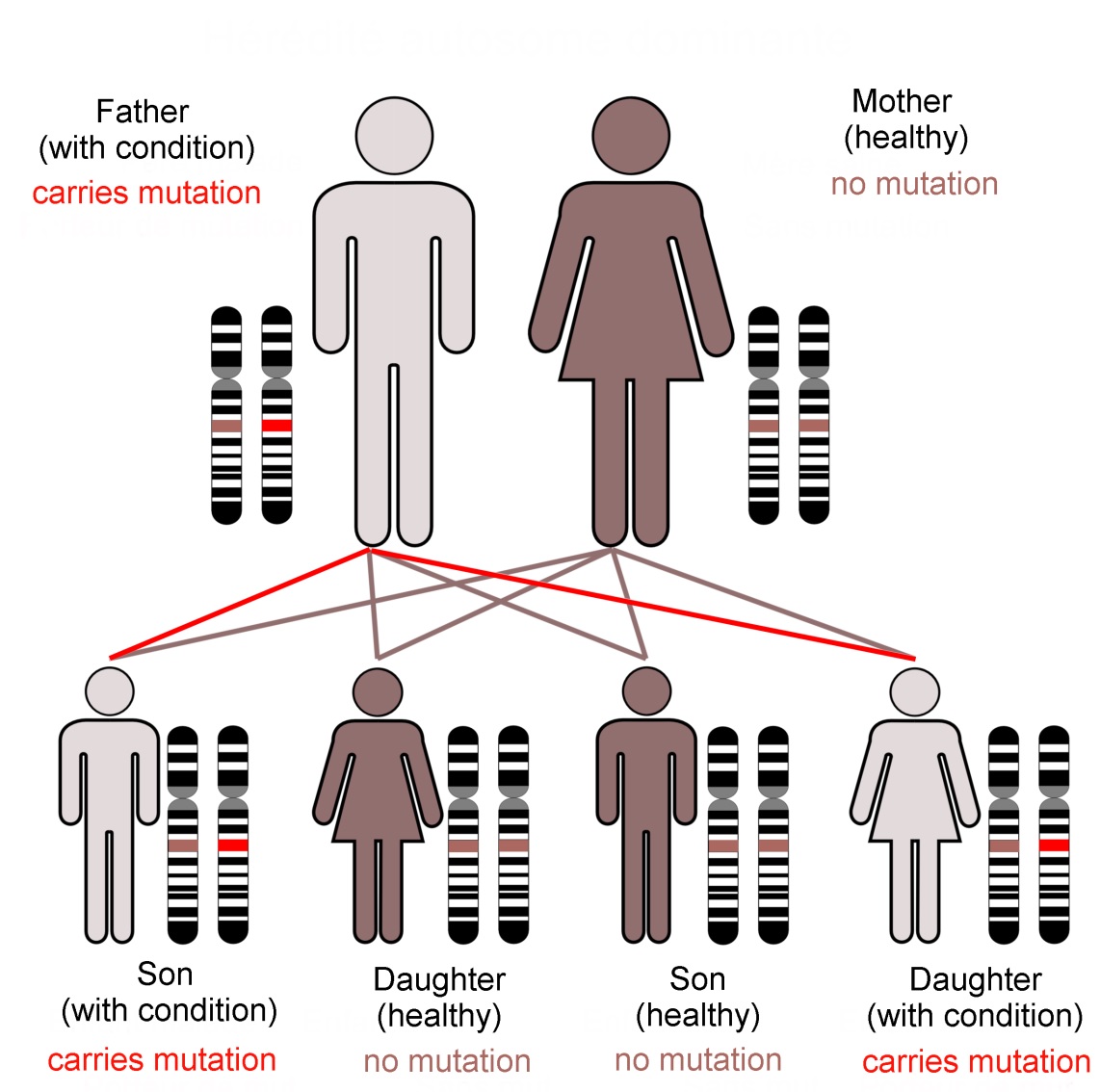
Family KE’s condition, caused by a dominant mutation in the FOXP2 gene, follows an autosomal (not sex-linked) pattern of inheritance, as shown here.Dominant mutations are visible when only one gene copy is present. In... more contrast a recessive trait is not seen in the organism unless both chromosomes of the pair carry the mutant form of the gene. The FOXP2 transcription factor protein is required in precise amounts for normal function of the brain. The loss of one working FOXP2 gene copy reduces this ‘dose’ which is enough to cause the problems that emerged as family KE’s symptoms (Image: Annotated from Wikimedia Commons)
In practice, very few of our 25,000 genes are individually responsible for noticeable characteristics. Most genetically inherited diseases result from the effects of multiple gene loci. FOXP2 is unusual because of its ‘dominant’ genetic character. It does not give us our language abilities, but it is involved in the neural basis of our mental flexibility and agility at controlling the muscles of our mouths, throats and fingers.
In addition, genes are only part of the story of our development. The way we think and subsequently behave alters our emotional state. Feeling stressed or calm affects which circuits are active in our brain. This alters the biochemical state of body organs and tissues, particularly of the immune system, modifying which genes they are using.
The dance between the code stored in our genes and the consequences of our thoughts builds us into what we are mentally, physically and socially. This story is ours to tell. By our experience, and with this genetic vocabulary, we create what we become.
Text copyright © 2015 Mags Leighton. All rights reserved.
References
Chial H (2008) ‘Rare genetic disorders: Learning about genetic disease through gene mapping, SNPs, and microarray data’ Nature Education 1(1):192 http://www.nature.com/scitable/topicpage/rare-genetic-disorders-learning-about-genetic-disease-979
Clovis YM et al. (2012) ‘Convergent repression of Foxp2 3′UTR by miR-9 and miR-132 in embryonic mouse neocortex: implications for radial migration of neurons’ Development 139, 3332-3342.
Enard, W (2011) ‘FOXP2 and the role of cortico-basal ganglia circuits in speech and language evolution’ Current Opinion in Neurobiology 21; 415–424
Enard, W et al (2009) A Humanized Version of Foxp2 Affects Cortico-Basal Ganglia Circuits in Mice Cell 137 (5); 961–971 http://www.sciencedirect.com/science/article/pii/S009286740900378X
Feuk L et at., Absence of a Paternally Inherited FOXP2 Gene in Developmental Verbal Dyspraxia, in The American Journal of Human Genetics, Vol. 79 November 2006, p.965-72.
Fisher SE and Scharff C (2009) ‘FOXP2 as a molecular window into speech and language’ Trends in Genetics 25 (4); 166-177
Lieberman P (2009) ‘FOXP2 and Human Cognition’ Cell 137; 800-803
Marcus GF & Fisher SE (2003) ‘FOXp2 in focus; what can genes tell us about speech and language?’ Trends in Cognitive Sciences 7(6); 257-262
Reimers-Kipping S et al. (2011) ‘Humanised Foxp2 specifically affects cortico-basal ganglia circuits’ Neuroscience 175; 75-84
Scharff C & Haesler S (2005) ‘An evolutionary perspective on Foxp2; strictly for the birds?’ Current opinion in Neurobiology 15:694-703
Vargha-Khadem F et al. (2005) ‘FOXP2 and the neuroanatomy of speech and language’ Nature Reviews Neuroscience 6, 131-138 http://www.nature.com/nrn/journal/v6/n2/full/nrn1605.html
Wapshott N (2013) ‘Martin Luther King's 'I Have A Dream' Speech Changed The World’ Huffington post, 28th August 2013 http://www.huffingtonpost.com/2013/08/28/i-have-a-dream-speech-world_n_3830409.html
Webb DM & Zhang J (2005) ‘Foxp2 in song learning birds and vocal learning mammals’ Journal of Heredity 96(3);212-216
Bats; hunters that see in sound
You are out in the dark, alone. You become aware of a distant rhythmical clicking noise. Sensing danger, you change direction and head for cover. Seconds later you are punched by wave after wave of sound that hits your body like a machine gun. The noise bears down on you, loud as an aircraft, faster and faster, blurring into a roar….
…You are a moth, taken by an echolocating bat.
Bats aren’t blind. Their eyes work, but they live in a different world, requiring an extra sense. Using high frequency sounds, also known as ‘biosonar’ or ‘echolocation’, they can see in the dark. We see, hear touch, smell and taste by picking up cues in our environment. Biosonar is completely different; there can be no signal without the call.

A bottlenose dolphin (Tursiops truncatus) with locator beacon; Persian gulf. This animal is part of a trained team of animals used by the US Navy for mine clearance in shipping lanes. Since most prey cannot detect high ... morefrequency sound, hunters using echolocation have a stealth surveillance system of near-military precision. Dolphin echolocation inspired naval underwater surveillance using sonar (Image: Wikimedia Commons)
This really is seeing in sound. Biosonar provides bats and some other animals, including dolphins, with a distinctive and sophisticated form of vision, giving detailed three-dimensional information over long distances in darkness or murky waters.
Bats illuminate their world with beams of directional sound
Most bats hunt using a range of frequencies, moving their heads to pulse sounds in different directions as they fly. Lower frequencies produce wider sound cones like a floodlight, and higher frequencies focus the beam like a spotlight.
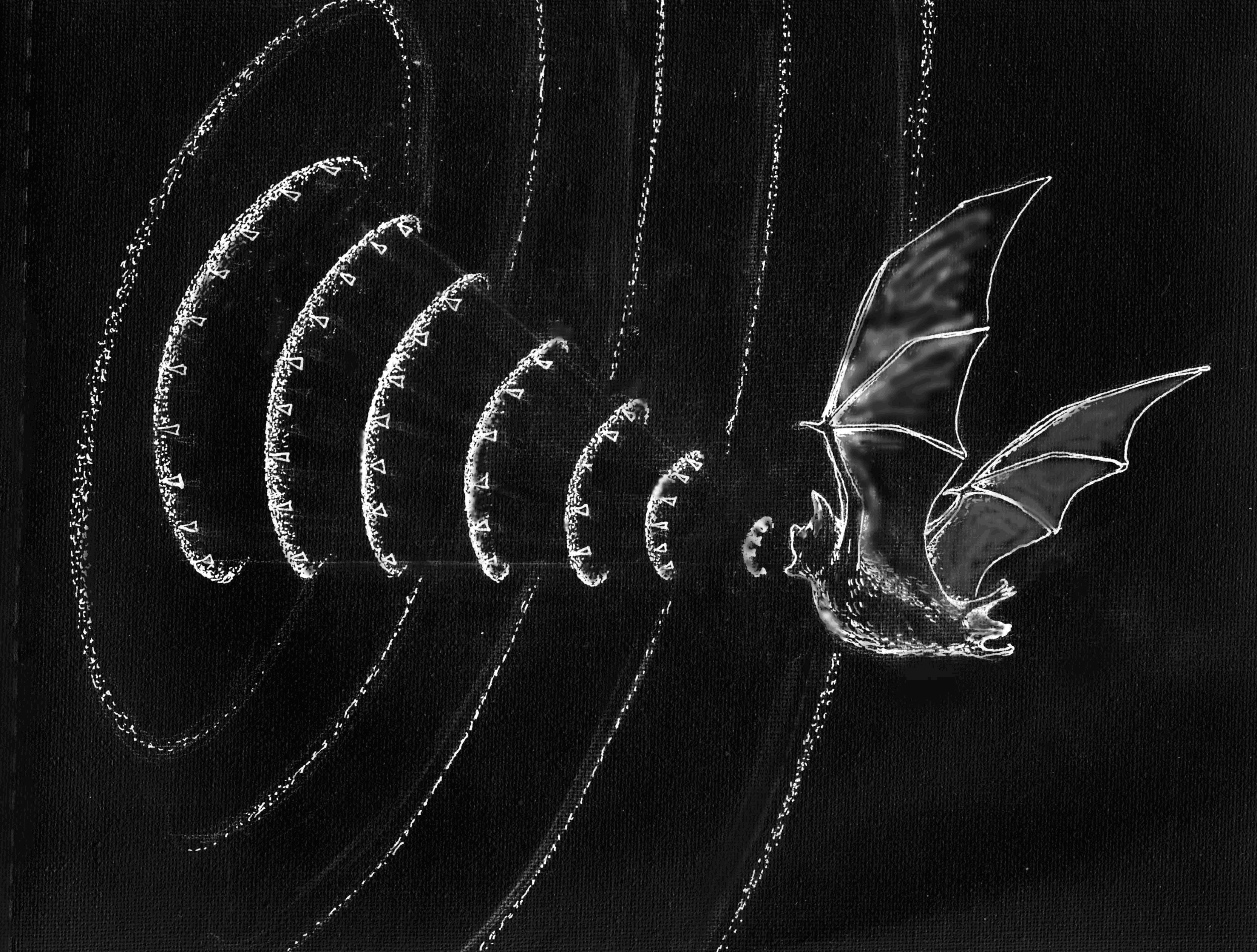
Bats and other echolocators emit pulses of directional sound that echo back from a target, returning them a cone of sonic information. They control the length and width of this cone by altering the frequency of their ca... morells and how far they open their mouths when producing the pulse. Larger mouths and higher frequencies produce longer, narrower ‘visual’ sound cones (Image: ©Simon Crowhurst)
Although one lives in the forest and the other in the ocean, the way bats and dolphins use biosonar when hunting is almost identical. Dolphins, like bats, both shift the frequency of their clicks as they scan and lock onto prey, giving a characteristic ‘buzz’ of rapid calls as they take the target. Sound travels more quickly under water, so dolphin sonar operates over a longer range.
Bats project sound and receive echoes the way that eyes scan an image
Watch someone’s eyes as they examine something; their gaze jerks from one area to another. These are known as ‘saccade and fixate’ movements. They focus different parts of the image onto an area at the back of the eye called the fovea, which sees detail. ‘Saccade and fixate’ eye patterns are found in all animals with good vision, and is a defining characteristic for how eyes focus on details.
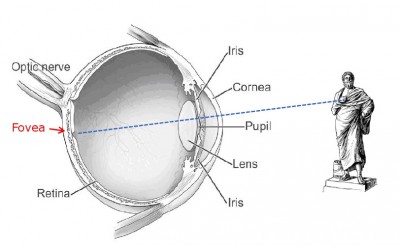
The human eye shifts its main focus in a series of ‘saccade and fixate’ movements. As this eye focusses on Sophocles’ hand, reflected light from the object lands on the fovea; the detail-harvesting area at the bac... morek of the eye. When looking at an object, our eyes move suddenly from one detail to another (the saccade), and then ‘fixate’ for a few moments onto these points of interest.Sophocles uses the idea of blindness in his story, ‘Oedipus Rex’, to illustrate how seeing is a highly active process, whether this is physical or metaphorical (Image: Composite of images from Wikimedia Commons)
When our eyes focus, they project an image onto an area at the back of our eyes known as the ‘fovea’. This zone is specialised to pick up high levels of detail. Any sense can be developed to pick up a high level of detail; we use sight, bats use sound, and star-nosed moles use touch.
Most bats hunt insects in the open air, listening for the returning echoes before making their next signal. They use a combination of head movements and focussed sound cones to gain information in a classic ‘saccade and fixate’ pattern. Wider head scanning and lower frequency calls provide a ‘wide angle’ view with less detail. Higher frequency calls and a narrow range of head movements create an ‘acoustic fovea’; this focuses their sonic gaze onto a small area and recovers detail, much like ‘zooming in’ using a macro lens.
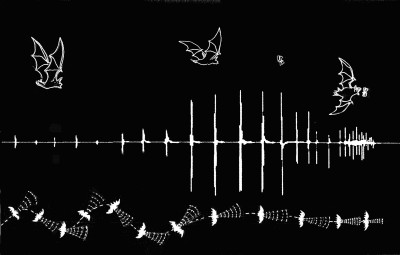
This artist’s impression shows the flight path (below) and behaviour (above) during the hunting sequence of a Common Pipistrelle bat (Pipistrellus pipistrellus), represented by the sound trace (centre). The process ha... mores distinct phases. During the initial ‘search’ (left), the call frequency is quieter (lower amplitude) and less frequent; this produces a wide angle sound cone. Upon detecting and approaching a target (centre), the hunter’s calls increase in volume and frequency, which focusses the acoustic gaze. As the hunter is locked onto its target (right), it produces a high frequency ‘buzz’. This highly focussed cone of sound allows the bat to perceive details, and manoeuvre very precisely as it closes in to take the prey.The time from detecting to taking the prey is less than a second. (Image: ©Simon Crowhurst)
Horseshoe bats use echolocation in a different way; an adaptation to hunting in and around the spatially variable (and hence acoustically complicated) ‘surface’ of tree and shrub canopies. They use mostly constant-frequency pulses, and listen for Doppler-shifted returning echoes. The cochlear membranes of their inner ears respond over a broad frequency range, but have particular sensitivity within a very narrow bandwidth (their acoustic fovea). When locking the sound pulse onto their prey, they alter their emitted call in order to keep the frequency of the returning echoes constant. This allows them to focus on the frequency modulations caused by the fluttering movements of large insects.
Echolocation reveals shape and form using ‘stereo’ images
Just as the brain uses the different view from our two eyes to build a stereo image, our brains use the differences between what is heard by our ears to understand something of the direction and distance of a sound source. Bats use this difference to understand and construct a ‘stereo image’ of their surroundings in three dimensions. This enables them to understand something of the shapes and textures of objects in their environment.
Some tropical bats are nectar feeders. Flowers hidden amongst the leaves are in an acoustically cluttered environment. Many flowering plants using bats to assist with their pollination have evolved floral structures that act as ‘sound beacons’. These are usually dish-shaped (parabolic) and bounce back an unique echo pattern that makes them become acoustically visible.

The Allen Telescope Array (ATA) built by the University of California, Berkeley and SETI (Search for Extra-terrestrial Intelligence). This offset Gregorian design reflects incoming radio waves caught by the large parabo... morelic dish onto the secondary parabolic reflector, which harvests the signal. The telescope is tuned to a frequency range from 0.5 to 11.2 GHz and will eventually have 350 antennae (Image: Wikimedia Commons)
Parabolic shapes also make excellent receivers. The Search for Extra-Terrestrial Intelligence (SETI) project’s radio telescope is made of many parabolic ‘ears’, listening for radio transmissions from outer space. Whilst we have invented technologies enabling us to hear bat calls and signals from beyond our planet, our own ears’ convoluted parabolic shape also captures sounds, and funnels them to our receiver; the ‘ear drum’ .
Text copyright © 2015 Mags Leighton. All rights reserved.
References
Fenton, M.B. (2013) Questions, ideas and tools; lessons from bat echolocation. Animal Behaviour 85, 869-879.
Connor, W.E. and Corcoran, A. J. (2012) Sound strategies; the 65 million year old battle between bats and insects. Annual Review of Entomology 57, 21-39.
Ghose, K. et al. (2006) Echolocating bats use a nearly time-optimal strategy to intercept prey. PLoS Biology 4, 865-873.
Jakobsen, L. et al. (2013) Convergent acoustic field of view in echolocating bats. Nature 493, 93-96.
Land, M.F. (2011) Oculomotor behaviour in vertebrates and invertebrates In The Oxford Handbook of Eye Movements(S.P.Liversedge, I.D. Gilchrist and S. Everling, eds), pp. 3-15. Oxford University Press.
Ratcliffe J A et al. (2012) ‘How the bat got its buzz’ Biology Letters 9;20121031
Siebert, A M et al (2013) ‘Scanning behaviour in echolocating common pipistrelle bats (Pilistrellus pipistrellus) Plos One 8(4);e60752
Simon et al (2011) ‘Floral acoustics; conspicuous echoes of a disc-caped leaf attract bat pollinators’ Science 333: pp631-633
Schnitzler, H-U. and Denzinger, A. (2011) Auditory fovea and doppler shift compensation: adaptations for flutter detection in echolocating bats using CF-FM signals. Journal of Comparative Physiology, A 197, 541-559.
Surlykke, A. et al. (2009) Echolocating bats emit a highly directional sonar sound beam in the field. Proceedings of the Royal Society of London, B 276, 853-860.
von Helversen, D. and von Helversen, O. (2003) Object recognition by echolocation; a nectar feeding bat exploiting the flowers of a rainforest vine. Journal of Comparative Physiology, A 189, 327-336.
von Helversen, D. and von Helversen, O. (1999) Acoustic guide in bat pollinated flower. Nature 398, 759-760.
Elephants’ aquatic ancestors; just below the surface
Pausing on the bank, the lead female gathers her herd, ensuring that she is followed before she plunges in.
The smaller elephants swim, heads fully submerged. Others walk at first. All are snorkel-breathing through their trunks.
A lone male follows at a distance. He watches the tribe for a moment before he too enters the water.
Elephants are the largest land mammals, and are at home in hot, dry savannah environments. They migrate hundreds of miles in search of food, and when required will cross rivers, lakes, and even undertake marine excursions. They are surprisingly strong swimmers, and are the only mammals able to snorkel.
This provides a vital evolutionary clue to their past. Although we associate elephants with dry land, their bodies reveal clear evidence of an aquatic ancestry.
Fossils and DNA put elephants amongst the swimmers
DNA evidence:
Comparing DNA sequencesenables usto build molecular phylogenies, or ‘family trees’, defining the genetic relatedness between species. These phylogenies show that elephants’ closest living relatives are the fully aquatic sea cows; the dugongs and manatees.
Fossil evidence:

An artist’s impression of the semi-aquatic Moeritherium by scientific illustrator Heinrich Harder (1858-1935) (Image: Wikimedia Commons)
Water molecules (H2O) contain three isotopes of oxygen; 16O, 17O and 18O. The lighter forms evaporate more easily, slightly enriching lakes and oceans with ‘heavy’ water. This then can become incorporated into aquatic plants and the bodies of animals that graze on them. Analysing the ratio of ‘light’ 16O to ‘heavy’ 18O isotopes (i.e. d18O) in teeth from fossils of the extinct elephant ancestor Moeritherium, show that they contain a higher proportion of 18O than teeth from land grazing animals. This tells us that it ate mostly freshwater plants, suggesting its lifestyle was at least semi-aquatic.
Elephant embryos reveal adaptations to breathing under water
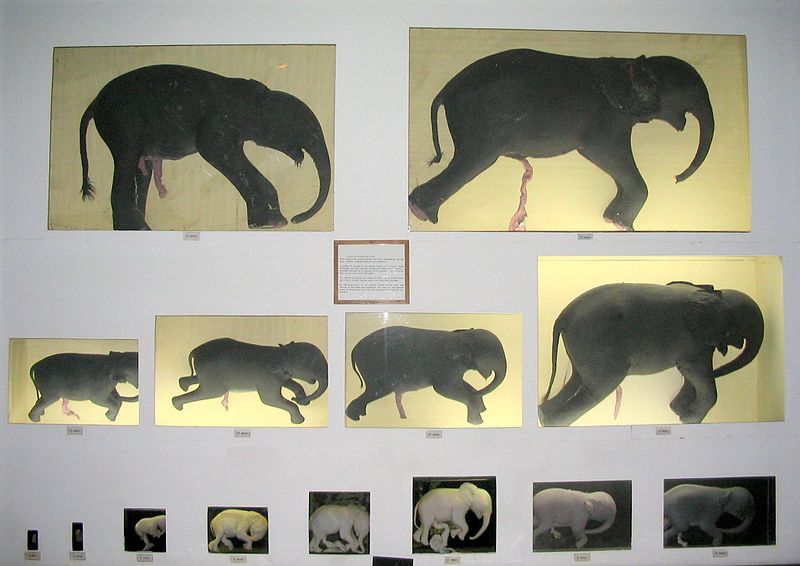
This photographic series of elephant foetuses shows the early appearance of the trunk. Natural History Museum, Maputo, Mozambique.An elephant foetus has detectable heart beats by day 80 of gestation, and the trunk start... mores to become visible at days 85-90. Overall, gestation is approximately 660 days (Image Wikimedia Commons)
Elephants can snorkel because of their elongated trunks, and elastic connective tissues that fill the space between their lungs and their body wall. Both of these features appear together early in the foetus, suggesting that they were important for survival of the elephant’s ancestors.
As in other large mammals, elephants’ blood pressure is high; this is needed to keep the brain well supplied with oxygenated blood. Under water, the differences between the pressure of inhaled air (atmospheric; 0mmHg) and the blood pressure in the capillaries (150mmHg) would be enough to rupture blood vessels and the delicate linings of the lung. Their elastic connective tissues act as shock absorbers, protecting the lungs against such damage.
Elephants’ testes are inside the body like other aquatic mammals

A male western grey kangaroo (Macropus fuliginosus) foraging near Port Douglas, Queensland. In hot weather, male kangaroos lower their scrotal sac away from the body; this helps keep these organs at a cooler temperature... more and avoids damaging their sperm (Image: Wikimedia Commons)
The location of a mammal’s testes is related to temperature. Excessive heat or cold will kill mammal sperm (including humans), causing sterility. Hence in puberty, boys’ testes descend into sacs that are slightly cooler than the interior of their bodies. However aquatic mammals continue to carry their testes inside their abdomen to protect them from cold. We would expect land-dwelling elephants’ testes to be carried in a scrotum. Instead, their testes remain inside the body like those of aquatic mammals.
Early in the foetal development of both male elephants and dugongs, an artery develops which directly connects their kidneys and testes. In contrast, the testes of most land mammals have a less direct connection, allowing them to descend into a scrotum during puberty. This suggests that like modern dugongs, the elephants’ ancestors lack a scrotum.
Aquatic mammals including dugongs have a plexus of blood vessels that cool their internal testes and uterus through a counter-current heat exchange mechanism. Testicular cooling by a blood plexus has not yet been investigated in elephants; however in the absence of heat stress, they maintain a body temperature of around 34-36⁰C, which is similar to the temperature of the scrotum in most other land mammals.
Elephants ears close for swimming

This skull (formerly from a zoo elephant, kept at Basle in Switzerland) has had a front (sagittal) section removed, to show the honeycomb of air cavities inside the bones. Elephants hear low frequencies (infrasounds) tr... moreansmitted through the ground and conducted to their skull and inner ears through the bones of their front legs. These sounds are amplified by resonating in these inner bone chambers (Image: Wikimedia Commons)
After swimming we often have to shake our head to clear water from our ears. However elephant ears have a unique sphincter-like muscle that closes the ear canal and prevents water entry when swimming. This also creates a sealed ‘acoustic tube’, which works with the aerated bones and ‘acoustic fat’ lenses of the elephant skull to amplify low frequency ‘infrasound’. Dugongs have similar aerated skull bones and fatty deposits; again implying that they share an aquatic ancestor.
Text copyright © 2015 Mags Leighton. All rights reserved.
References
Fowler, M.E. and Mikota, S.K. (eds) (2006) Biology, Medicine, and Surgery of Elephants. Blackwell.
Gaeth, A.P. et al. (1999) The developing renal, reproductive and respiratory systems of the African elephant suggest an aquatic ancestry. Proceedings of the National Academy of Sciences, USA 96, 5555-5558.
Hildebrandt, T. et al. (2007) Foetal age determination and development in elephants. Proceedings of the Royal Society of London, B 274, 323-331.
Johnson, D.E. (1978) The origin of island mammoths and the Quaternary land bridge history of the Northern Channel Islands, California. Quaternary Research 10, 204-225.
Johnson, D.E. (1980) Problems in the land vertebrate zoogeography of certain islands and the swimming powers of elephants. Journal of Biogeography 7, 383-398.
Liu, A.G.S.C. et al. (2008) Stable isotope evidence for an amphibious phase in early proboscidean evolution. Proceedings of the National Academy of Sciences,USA 105, 5786-5791.
McKenchie, A.E. and Mzilikazi, N. (2011) Heterothermy in Afrotropical mammals and birds: a review. Integrative and Comparative Biology 51, 349-363.
O’Connell-Rodwell, C.E. (2007) Keeping an ear to the ground: seisemic communication in elephants. Physiology 22, 287-294.
Poulakakis, N. et al. (2006) Ancient DNA forces reconsideration of evolutionary history of Mediterranean pygmy elephantids. Biology Letters 2, 451-454.
Poulakakis, N. and Stamatakis, A. (2010) Recapitulating the evolution of Afrotheria: 57 genes and rare genomic changes consolidate their history. Systematics and Biodiversity 8, 395-408.
Seiffert, E.R. (2007) A new estimate of Afrotherian phylogeny based on simultaneous analysis of genomic, morphological and fossil evidence. BMC Evolutionary Biology 7, 224.
Springer, M.S. et al. (2004) Molecules consolidate the placental mammal tree. Trends in Ecology and Evolution 19, 430-438.
Weissenbrock, N.M. et al. (2012) Taking the heat: thermoregulation in Asian elephants under different climatic conditions. Journal of Comparative Physiology, B 182, 311-319.
West, J.B. Why doesn’t the elephant have a pleural space? Physiology 17, 47-50.
West, J.B. et al. (2003) Fetal lung development in the elephant reflects the adaptations required for snorkelling in adult life. Respiratory Physiology and Neurobiology 138, 325-333.
West, J.B. (2001) Snorkel breathing in the elephant explains the unique anatomy of its pleura. Respiration Physiology 126, 1-8.


